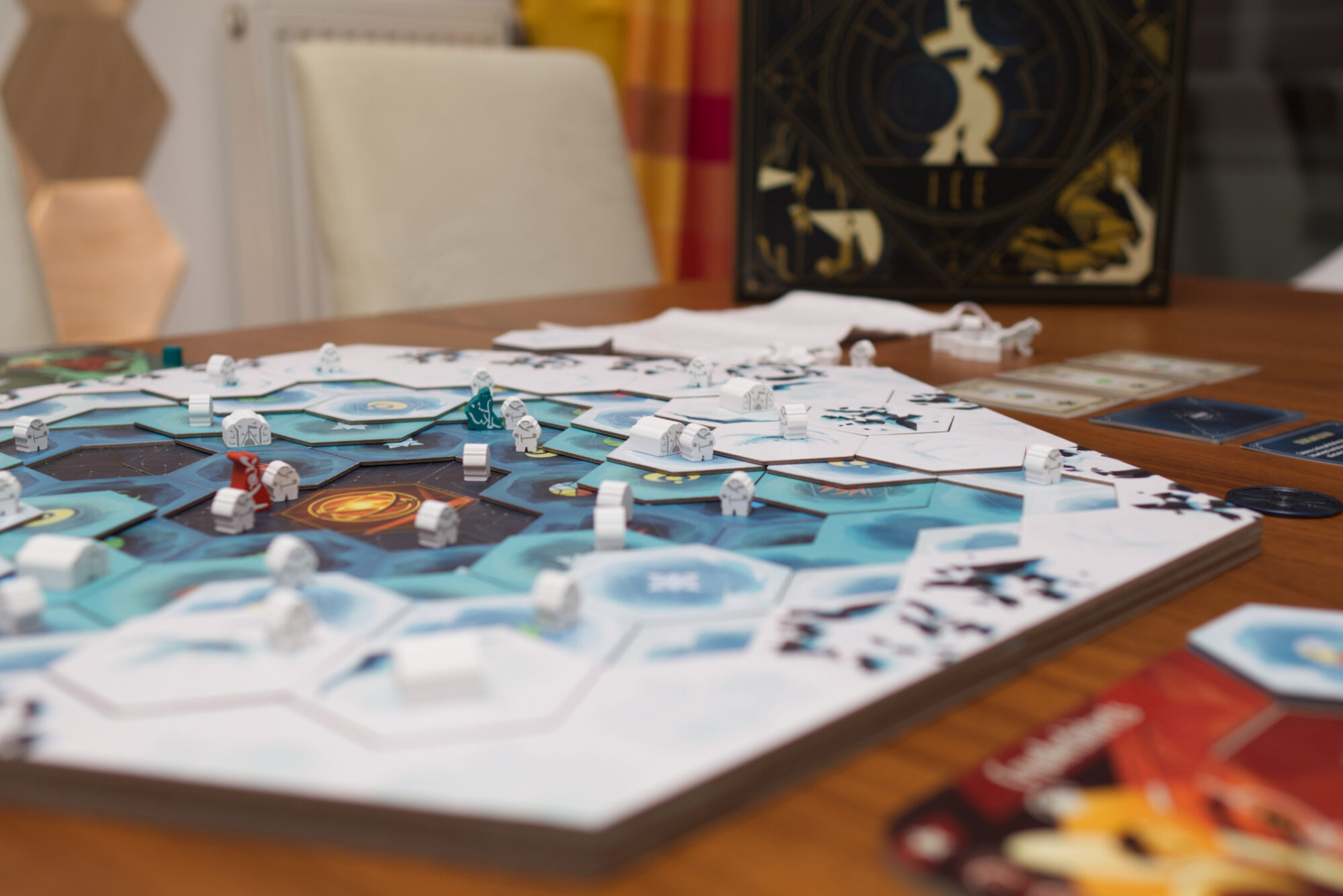Can board games be art? What might have been a controversial question back when I started in the hobby has without a doubt by now been answered by a resounding “YES!”. We have more and more artists that no longer are only mentioned in the fine print (or not at all) but are printed on box covers just along the game’s designer. People like Beth Sobel, Vincent Dutrait, or Ian O’Toole have become household names … at least in households with more than lets say 50 board games. In the case of Ian, he’s even a reason why people get interested in a game and might pick it up, as can currently be seen by all the buzz around Galactic Cruise.
There has been a steady increase in production quality and artwork over the years, even before Kickstarter. I still remember being at SPIEL Essen one year and seeing a copy of Tokaido through the transparent shopping bag of another visitor. I had no idea what the game was about, but I was immediately hooked. That clean white look, that beautiful cover illustration! Although the closing sound of the fair had already sounded, I rushed towards the publisher’s booth, hoping to get there before they closed shop, and in parallel called a friend to check if the game was actually any good. It was, and so I picked up a copy. I think that was the first time I bought a game blindly just because of how it looked.
Fast forward many years, and we’re now at a point where I get rather suspicious when a game looks too good. There simply have been too many crowd funding projects that tried to make up for mediocre game play with fancy miniatures and gorgeous digital art. The base idea behind ICE sounded interesting though: digging through layers of cardboard tiles. I was torn, but ultimately decided to not back it. How much game could there be? But as happens on occasion, I got curious and so organised myself a copy to see what’s what…
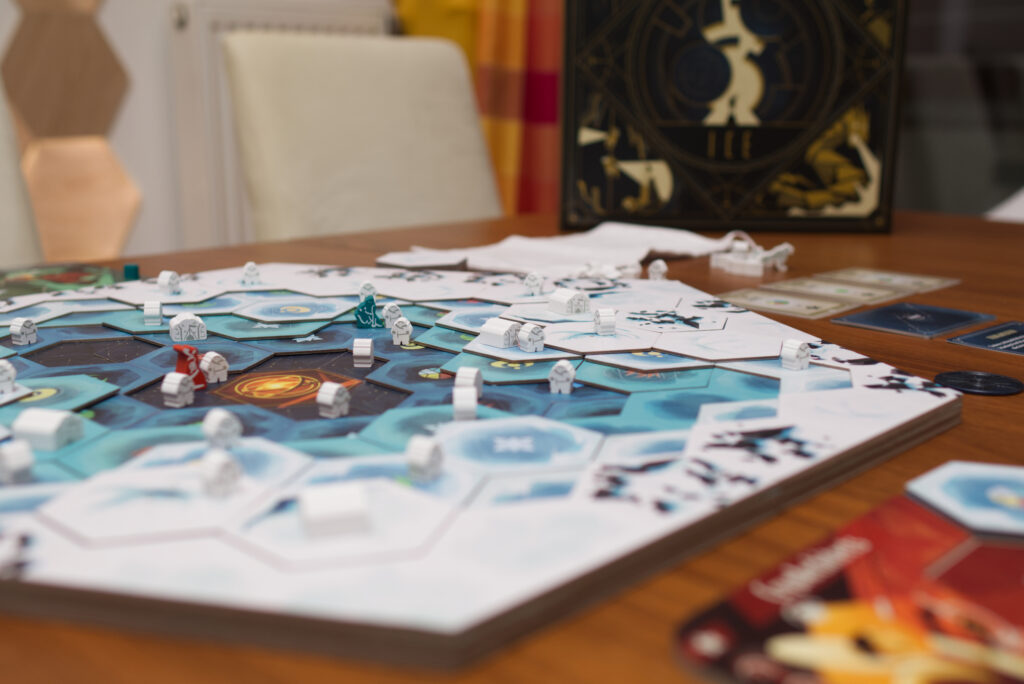
Setup
One thing that is undeniable is: this is definitely among the most beautiful board games I’ve ever seen. I might as well write it here and not in the conclusion because even holding the Collector’s Edition box feels like holding a piece of art. It has the industry standard ticket-to-ride sized footprint but at 1.5-2x height.

Inside the box is an insert that on the top holds the 4 segments that form the board. In the Collector’s Edition, the pieces are even magnetised and thus snap together, which is quite satisfying. However, the board already is a first indication that there were some production issues with ICE as the multiple layers forming the board are not uniform on top of each other which is an odd look for such a pricy product.
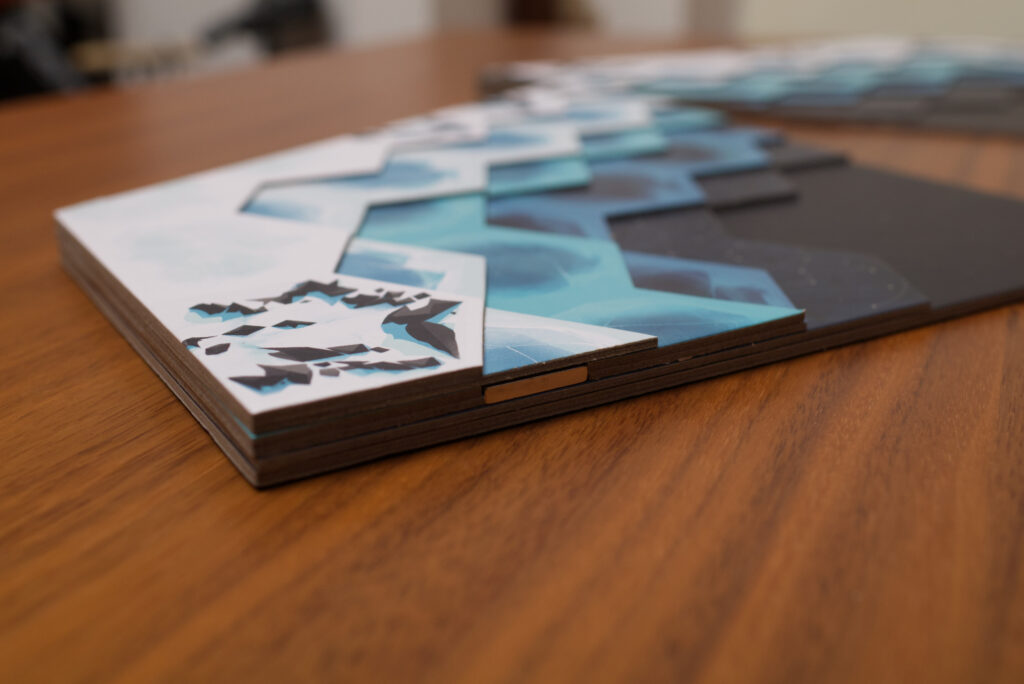
Assembled, the board is quite large and substantial. It forms an area for 5 layers of cardboard hex tiles, each having a different coloured background. Each layer’s pieces are mixed by themselves and then slotted in. The bottom layer consists of 12 unique Edifices, powerful objects that are the reason why the players are digging through all that ice. On top of it come three layers of artifacts which can give the players additional actions/powers as well as being the main source of victory points.

The top-most layer consists of white snow tiles. On the back side (which is the one that’s visible initially) are empty spaces, tunnel entrances (which functionality are the same as empty tiles but start with an archeologist worker on them), rifts that cannot be moved over and rocks where it is harder to dig at. Finally, there is a single camp tile on which a wooden camp is placed. This is another slight oddity: all wooden pieces are only screen printed from one side which kind of felt odd for such a stylised product. As it turns out, there was some issue during production and in fact the tiles had originally been planned to be printed from both sides. It’s not a problem, but would of course have made the game look even more beautiful.
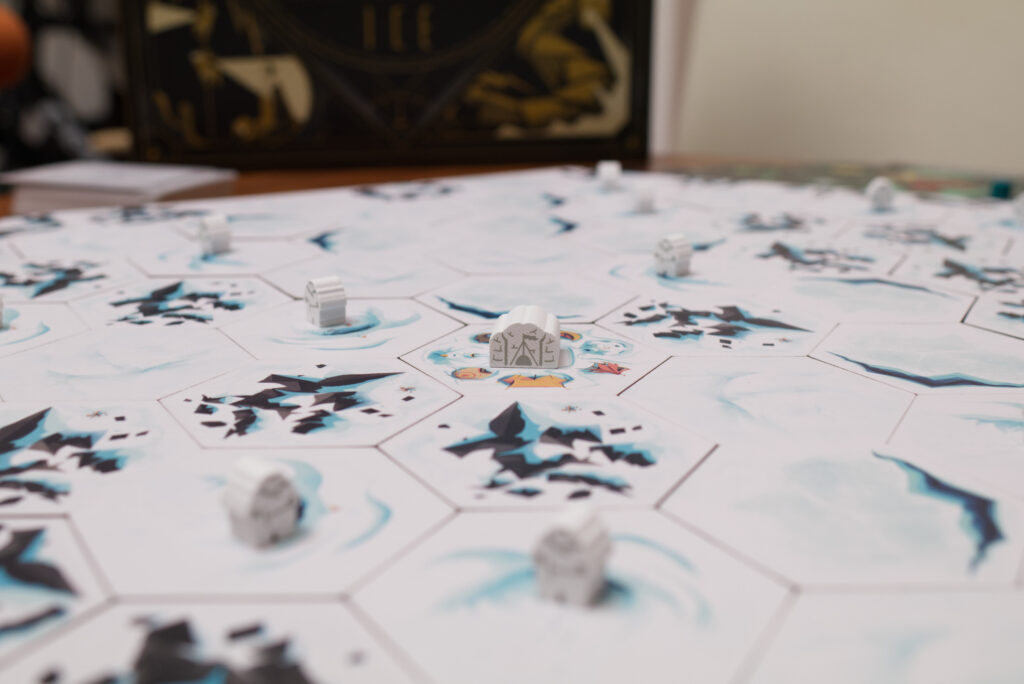
Each player gets 2 private request cards showing a combination of which artifacts to collect and 3 public goals that affect all players are drawn. They also chose a unique guild (of which there are 7) and get the dual layer player board and matching expedition leader figure. Finally, a deck of 6 logbook cards is created.
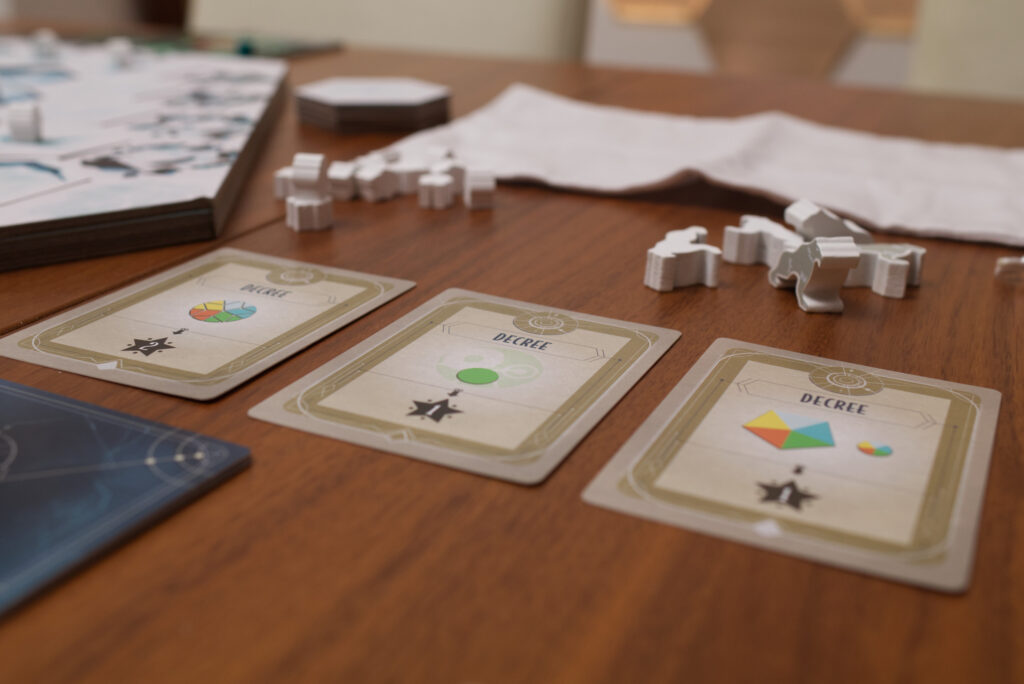
The Turn
Each round except for the first one starts by revealing a logbook card. These either provide each player a small bonus or award something to the player that’s the furthest behind. The deck also acts as the timer of the game, but in general feels odd. The effects are a) random and b) too inconsequential to really make a difference. The only exception is a single card that basically skips to the next card and thus shortens the game.
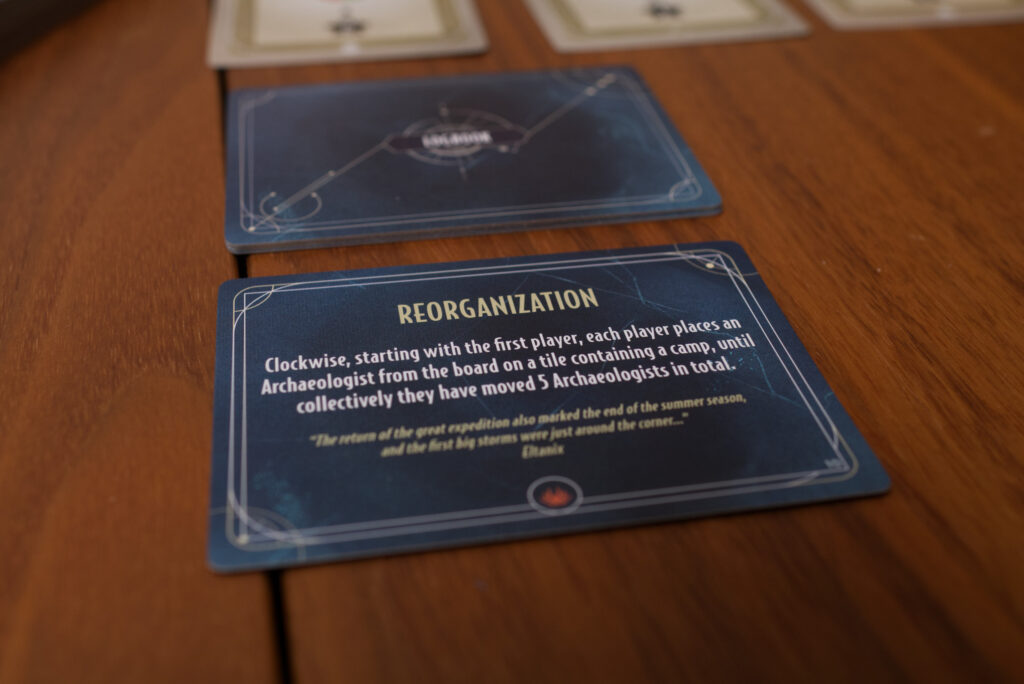
Then all players reset their expedition point (EP) track back to 5, representing their available action points, and flip any artifacts they have stored on their board back so they are facing up. There is one space on the board for each of the five colours of artifacts in the game. All artifacts of that type that a player collects will be placed on that spot and when a player has either at least two artifacts with a single dot (called anima) or one artifact with 2 dots on them of a colour, they can flip the whole stack as a free action to trigger various effects like burning a piece of ice away or getting an extra EP.
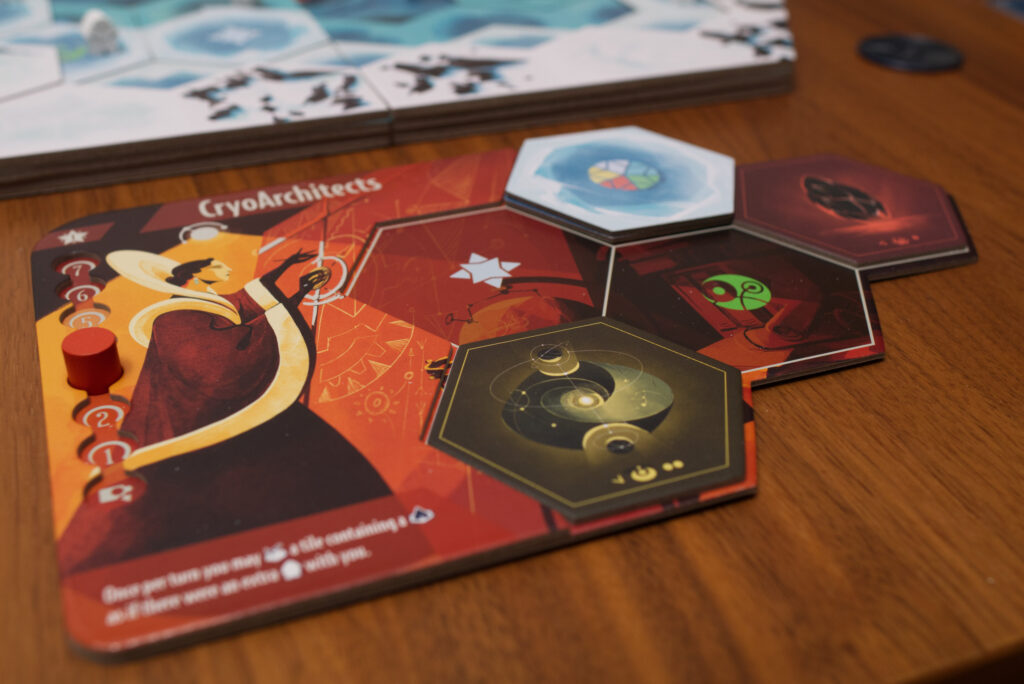
When it’s a player’s turn, they must spend at least one or at most two EP to perform actions before passing to the next player and the round is complete once all players can no longer perform any actions.
It costs a player 1 EP to send their expedition leader or a new archeologist to a camp, 1 EP to build a new camp on any tile that is not covered and “teleporting” their expedition leader to the same space, 1 EP to move their expedition leader to a neighbouring space (and taking up to 3 archeologists with them), and finally a variable amount of EP to dig out the tile their expedition leader is standing on. The base cost of this is 3EP plus 1 if the tile is a rock tile and an additional one if there is a camp on it. How can one dig for 3+EP when one is only allowed to spend up to 2 EP in a single turn? Every figure on the tile (the player’s expedition leader, neutral archeologists, and even opposing expedition leaders) help digging and thus subtract 1 EP each from the digging cost. This can lead to digging being a free action, allowing a player to effectively do more than 2 actions even with a limit of 2 EPs of spending.

The digging player then claims the tile and distributes all involved figures evenly on the lower layer. This placement is crucial as one wants to enable further digging for oneself without providing free workers for others.
Artifacts go on the player’s guild board, snow tiles on their hand as they act as a one-time special effect that can be used as a free action at a later point. These include things like temporarily placing a tiger on a hex to block opponents or moving your expedition leader to an arbitrary space.

There are a few additional rules when it comes to digging, but overall the rules are not that complicated. If a tile is only connected to a single other tile on the same layer, it breaks away and is discarded. This can lead to interesting chain effects. In addition, a player can dig a tile that is still covered by a single other tile on top of it. This increases the digging cost by 1 EP and that top tile is discarded instead of it going on to the player’s hand.
By spending 1 VP, the spending limit for a single move can be increased to 3 EP, and a single 1 EP can be spent to carry it over to the next round. Players can also spend EP to draw new requests cards for additional end game scoring.
The final action a player can take is end their whole round early which allows them to send an additional artifact to “the city”. Without it, they are normally allowed to put up to 3 artifacts from their player board aside and score VP equal to the number of anima dots on them. The main reason to do so though (and thus removing artifacts that could be flipped for their special powers) is that only those that have been put away during the game are actually scored at the end of the game.

Player Powers
One important aspect of ICE is that each guild (=player colour) comes with a unique power. Although the designers have stated that they are similar in power but different in complexity of playing them correctly, we in practice found some way more powerful than others. For example, one has a free once-per-round activation of an artifact effect (e.g. get a free 1 EP, claim a tile that is being discard) which is quite powerful especially in early game while another only doesn’t get a penalty when digging on a camp side.

Game End
The game ends either when an Edifice is uncovered, at which point it is automatically flipped (and doesn’t need to be dug out) or the logbook deck runs out. At this time, the public goals and private request cards are scored. To put it simple, they show either various combinations of coloured artifacts that are needed to score them or some similar criteria of artifacts.
A nice touch is that the unique Edifice that has been uncovered dictates which variant rules are used for the next play of ICE, e.g. making it easier for ice to break away. Unfortunately, players have to memorise this as all 12 edifice are needed to fill the bottom layer. Instead of adding a 13th tile and keeping the active next to the board, which would have been a simple solution, the publisher offers a set of optional cards that can be used to show which set of rules is currently used. Seems like an odd choice.
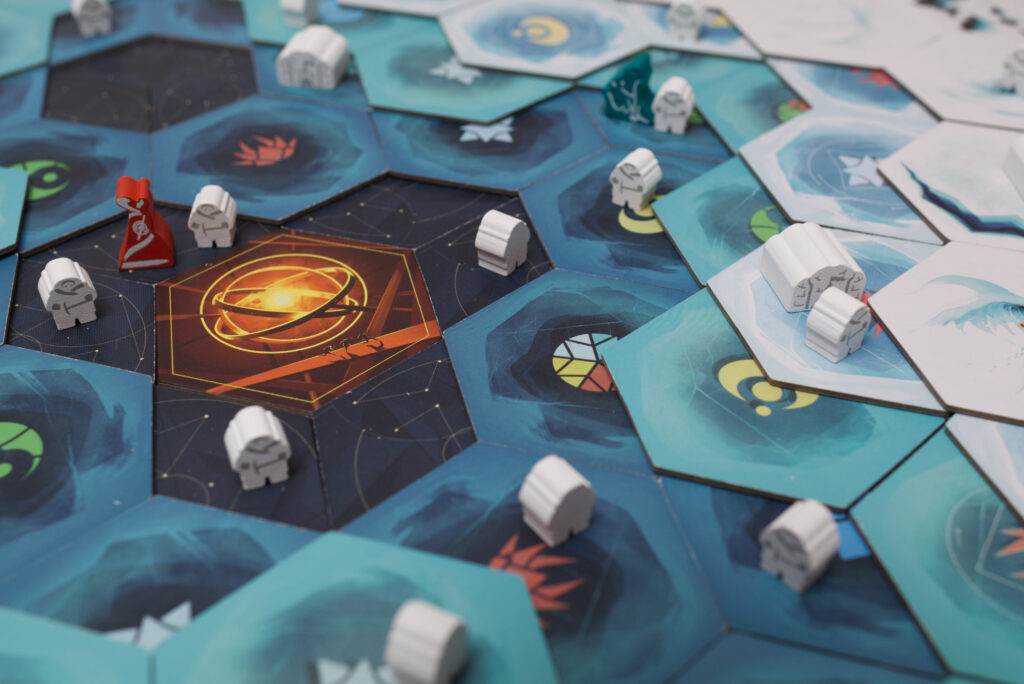
Production
The art style and illustrations of ICE are just gorgeous, the tactile feel is good and the metal coins nice. Unfortunately, the quality of the product seems to be another story. The hex tiles immediately looked scuffed, the board wasn’t properly aligned during gluing, things fly around in the custom insert when storing the box vertically, etc. It’s nothing that would hurt the enjoyment of ICE, but it shows that this is the product of a first time publisher and that producing ICE was challenging to say the least (e.g. here is a blog post about why the second edition needs to be simplified). From what I gather, the costs during production skyrocketed so much that they even had to produce the game at a loss. Even more so, it needs to be commended that they fulfilled on their promise and actually managed to ship the game to backers with minor concessions.

Solo Mode & Player Count
Games like ICE are usually not lugged around often. It’s just too much money and the box too big to carry around. On the other hand, I didn’t expect to get this to the table too often with my usual group of mid-heavy gamers. As a result, I was very interested in the solo mode … which unfortunately was a let down for me. It reminded me of Maglev Metro in that the solo mode is an efficiency puzzle that is very different from the cut-throat interaction of the multiplayer experience. In essence, the solo player has to manage sending a certain number of artifacts to the city and fulfilling a certain number of requests before the end of the 10th turn.
I’ve played it two times and then completely lost interest in playing ICE solo again. I think this is a missed opportunity and with a slightly more evolved automa-based solo mode, ICE could have been a lovely solo experience. Two player was okay, but I felt the game really shined with 4 players (I didn’t have a chance to try it at 3 but think that would also work well).

Conclusion
I had expected ICE to be a rather light game and was fine with that. The art looked lovely, the board definitely had table presence, why not have such a game in my collection? I didn’t expect the action to be this puzzly and cutthroat. While the ability to teleport one’s own expedition leader to any camp – or – as long as there are still camps available just jump them anywhere (by building a camp) feels really odd thematically, it allows for some prime stealing of workers. Players constantly have to be careful to not create opportunities for the next player to dig something out for free that they have worked towards.
The fact that the backside of the ice tiles actually shows the colour of the tile’s artifact helps in that sense. During setup, most players wonder if it isn’t a problem that they have seen where which colour is, but in reality, it doesn’t matter that much. What is much more important is to a) have enough workers to dig cheaply and b) dig when no one else is around to snatch your price away from under your nose. Knowing which colour of artifact can be found where rather helps to create choke points as players race to collect those colours that will score them the most for the public goals or allow them to use the artifacts special power.
At its best, ICE has these interesting moments of some large chunk of ICE breaking away, revealing new treasures, or one player having overlooked something and another swooping in. These feel great, at least for the player that benefits. Unfortunately, as a whole, playing ICE wasn’t the satisfying experience I had hoped for though. There is just too much arbitrary jumping, the player powers not balanced enough, the logbook cards too random, the snow tiles too situational, and players can easily end up in prolonged stretches where they can’t really do anything. It’s difficult to describe, but at the end of the game, it felt like ICE hadn’t fulfilled on the great promise it made at the start of the game.
I’ve already passed my copy on to someone else and kind of miss this beautiful piece of art. At the end of the day, I had to ask myself though: is it worth keeping this giant box and all that money on my shelf when I was certain that we would hardly ever bring the game to the table? Having table presence and gorgeous art simply isn’t enough for that. If I would have a lot of space available, I might have placed it on a sideboard and left it build up, as a gorgeous piece of 3D art to admire, like those books that we buy for our coffee tables but then never read …
